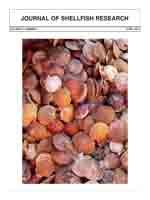Three size classes of mussels (Mytilus spp.) (small, 26–35 mm; medium, 45–54 mm; and large, 65–74 mm) were exposed to 4 experimental diets consisting of mixed algae, diatom pastes, salmon feed “fines,” or salmon feces. Salmon culture byproduct particles (feces and feed fines) were found to have minimal effect on the biophysical properties of mussel feces when compared with those from an algal-based diet. Differences in fecal morphology (feces widths) of mussel feces were found to be minimal in small mussel sizes, but became more significant as mussel shell length increased (45–74 mm). Furthermore, faeces from fish farm-based diets were found to be significantly narrower than algal based diets. Absorption efficiencies of the 4 different diets were 87%, 81%, 90%, and 86%, respectively. Regardless of diet, small mussels produced feces that dispersed as a function of settling velocity (small, 0.18 cm/sec; medium, 0.29 cm/sec; and large, 0.54 cm/sec (settling velocity of 50% of particles)) over much larger areas than those feces produced by larger mussels, suggesting that the influence of mussel culture on benthic loading of organic material around an aquaculture site will tend to increase over time as the mussel crop grows to maturity.
How to translate text using browser tools
1 April 2012
Quantifying the Effects of Diet and Mussel Size on the Biophysical Properties of the Blue Mussel, Mytilus spp., Feces Egested Under Simulated Imta Conditions
Matthew Liutkus,
Shawn Robinson,
Bruce MacDonald,
Gregor Reid

Journal of Shellfish Research
Vol. 31 • No. 1
April 2012
Vol. 31 • No. 1
April 2012
absorption efficiency
blue mussel
diet effects
feces size
Mytilus
settling velocity




